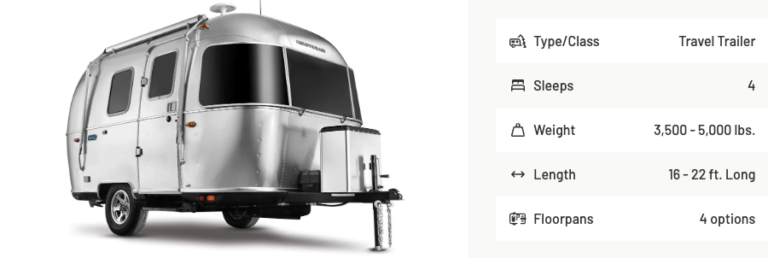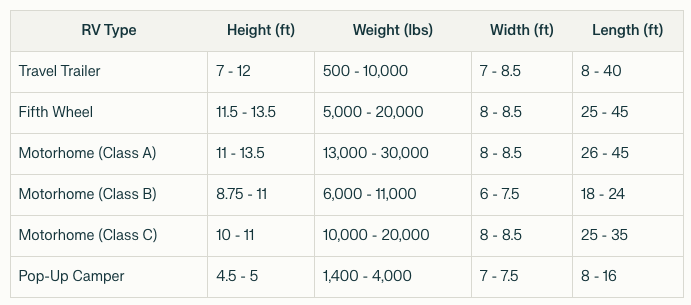
Your RV dimensions are an important bit of information to have when you hit the road! You’ll want to know your RV weight, height, width, and length for several reasons. Sometimes you’ll need it to make sure you can fit into a campground spot. You might need these figures to make sure you can drive certain roads. You might need to know your height if you’re entering a parking garage. And there are many more circumstances where having RV dimensions is not only useful, but might be crucial.
Let’s take a look at common dimensions, and at how to determine your own measurements.
- Drivable Motorhome Dimensions
- Towable Trailer Dimensions
- Parking Restrictions and Regulations
- Driving Considerations
- How to Measure Your RV
Common RV dimensions:

For a more specific deep dive, our RV manufacturers’ digest provides detailed dimensions for most RVs available on the market.
Drivable Motorhome Dimensions
When people talk about motorhomes, they’re actually talking about a range of vehicles, including some you may not have considered! Class A motorhomes are the largest RVs out there. They’re the large bus-style motorhomes and can sleep up to ten people. They usually have at least one full bathroom (sometimes two!) with a shower, a kitchen with a fridge, sink, stove, oven, and microwave, an entertainment area with seating and a TV, a bedroom, and other seating that converts to beds at night.
Class A Dimensions on Average
Class A motorhomes have a range of heights, weights, and widths. On average, they’re between 11 feet and 13 feet 6 inches tall. However, air conditioning units are not usually considered in this figure. If you have an air conditioner, a roof-mounted satellite dish, or anything else on your roof, you’ll need to consider those items in your height calculations.
And you’ll want to know this number before you head out on a trip! You’ll want to be sure your RV can drive under overhangs, bridges, and other obstacles without getting damaged.
As for width, most Class As run between 8 to 8 1/2 feet wide. However, this does not take slideouts into account. Some RVs can almost double in width when their slideouts are deployed. You’ll want to know how wide your RV is with the slideouts out when you’re in certain campgrounds.
Class A motorhomes also range in length, from 26 to 45 feet. You’ll need this number to determine if you can drive certain winding roads or passes. These roads sometimes have length or weight restrictions for larger vehicles.
The RV weight of Class A motorhomes varies widely as well. Smaller Class As can be 13,000 pounds, while large ones can be 30,000. You’ll want to find out the weight of your RV, and you might want to get your RV weighed when it’s fully loaded as well.
Class B Dimensions on Average
Class B motorhomes are campervans. They’re the smallest and lightest of the motorhome categories. Campervans sometimes don’t carry much more than a bed, but the most elaborate can have a small kitchen, a toilet, and a wet bath. They usually sleep 1-2 people but some campervans can accommodate up to four. Most campervans are between 8 1/2 to 11 feet tall and their RV weight is between 6,000 to 11,000 pounds. They’re 6 to 7 1/2 feet wide. Class B campers are usually between 18 to 24 feet long.
Class C Dimensions on Average
Class C campers are a nice compromise between Class As and Bs – they’re the Goldilocks camper! Not too big and not too small. Class C campers are often built on a truck chassis. They have a large back area, and an over-cab area that’s usually extra sleeping space. Class Cs usually have a kitchen, a bathroom and shower, a bedroom, the over-cab sleeping space, and dining or entertainment areas that convert into more beds. They range in height from 10 to 11 feet, in RV weight from 10,000 to 20,000 pounds, and in width from 8 to 8 1/2 feet.
Class C campers can often have slideouts as well, and you’ll want to keep that extra width in mind when you set up to camp. Also, as with Class A motorhomes, Class C campers can have air conditioners, fixed satellites, and other items on the roof. You’ll want to consider those when determining the height of your rig.
Class C campers are mostly between 25 to 35 feet long. They take a little practice to drive, but are not as intimidating as a long Class A motorhome.
Towable Trailer Dimensions
Trailers are the other major category of RVs – they’re an RV that you tow along behind you. You’ll need to know the height, width, and weight of any trailer you might tow for many reasons. One of the most important, however, is so you can make sure you have the right kind of vehicle to tow your trailer. A heavy trailer is going to need a much larger towing vehicle than a light teardrop trailer.
Also, keep in mind that roads with vehicle length limits usually include the length of both your tow vehicle and your trailer. You’ll need to know the combined length of the two vehicles. Also, if you’re towing with a tall truck, you’ll want to know the height of your truck as well. For height restrictions, you’ll need to consider the height of your tallest vehicle, whether that’s your towing vehicle or the trailer itself.
Travel Trailer Dimensions on Average
Travel trailers include a wide range of trailers. Everything from a teardrop camper to a much larger trailer falls into this category. Teardrop campers can be towed by a small SUV, and sometimes even a car. Larger trailers will need a big SUV or truck to be able to handle the size and weight.
Travel trailers range in height from 7 to 12 feet tall. They can weigh from 500 pounds for small teardrops to 10,000 pounds for very large travel trailers. They also vary in width, from 7 to 8 1/2 feet.
Fifth Wheel Dimensions on Average
Fifth wheel trailers have a special hitch that connects to the bed of the truck that is towing them. They’re more stable, and can be much larger than travel trailers. In fact, fifth wheel trailers can rival or surpass Class A motorhomes in terms of how much living space they offer.
Fifth wheel trailers range in height from 11 1/2 to 13 1/2 feet tall. They have an RV weight between 5,000 to 20,000 pounds, and they are between 8 to 8 1/2 feet wide. They can be between 25 to 45 feet long. Fifth wheels have slideouts, so you’ll need to take those into consideration if you need width measurements for a camping spot.
Pop-Up Camper Dimensions on Average
Pop-up campers lay down flat when they’re towed. They’re set up when you get to camp. There are A-frame and more square-looking pop-up campers. Pop-up campers can sleep between two to eight people, but most comfortable accommodate around four. Some pop-up campers are very basic, with just sleeping space, while others can have bathrooms with toilets and showers and outdoor kitchens.
Pop-up campers range from 4 1/2 to 5 feet tall when closed. They are 7 to 7 1/2 feet wide and can range from 1,400 to 4,000 pounds. You’ll need to know the weight when deciding what kind of vehicle you should have to tow a pop-up camper. Pop-up campers are from 8 to 16 feet long.
Parking Restrictions and Regulations
National Parks: National park campgrounds often have limits for the length of RVs staying there. Usually this isn’t because the campground itself can’t accommodate longer RVs. It’s because the winding roads to get to the campground can’t be managed by larger rigs. Most national park campgrounds can accommodate RVs between 25 and 40 feet long, but some go as low as 19 feet and as high as 42. Some parks also have some campgrounds that accommodate longer RVs and other campgrounds that don’t. Check with the campground you’re interested in using before you make a reservation if you’re unsure!
If you’re not using a tow car or shuttle bus to get around the park, you’ll also want to know where RVs and campers are allowed to park while you’re seeing the sights.
State parks: Various state parks may also have restrictions on the height, length, or width of RVs, often for the same reasons as national parks. Overhanging trees, telephone wires, and other obstacles can also be a factor where height is concerned. And some parks want you to have a special permit for oversized vehicles. Make sure you know the requirements for the state park campground where you want to stay!
Campgrounds: Private campgrounds can also have restrictions on the length, height, and other dimensions of RVs. Usually this is because of sharp turns on the way to camp or on the grounds themselves. There could also be overhangs and other obstructions. You’ll want to make sure your rig fits within the restrictions of any campground you book.
Storage: Finally, if you plan to store your RV somewhere – especially in covered storage – you’ll need to know the dimensions of your rig to make sure it fits! If you’re purchasing a cover to store your RV at home, you’ll also want to know your dimensions to make sure the cover will fit.
Driving Considerations
As you plan your RV road trip, you’ll want to keep your dimensions in mind as you travel. When you plan out your route, look for any restrictions on height for bridges, tunnels, and other obstructions. Some roads also have weight limits. And some have vehicle length limits because they’re extremely steep or winding. You’ll want to check all of those restrictions against your RV measurements to make sure you can use the roads you plan to use.
How to Measure Your RV
Since you’ll need to know the length, width, height, and weight of your RV – let’s figure out how to get those numbers! To measure your RV, you’ll need to do the following:
- Get a tape measure long enough to measure your entire vehicle. You may want a friend to hold one end of the tape while you measure. You’ll also want a notebook, app, or other place to record your measurements, and keep them easily accessible during your trip.
- Attach everything you’ll be taking on a road trip. If you have extra storage or bike racks, propane tanks, or any other add-ons, put them on while you measure.
- Get all possible lengths you can. Measure just your trailer. Then measure your tow vehicle. Then measure both together, all hooked up. Measure with all your extras like propane tanks and bikes on, and with them off.
- Measure more than once. Take several measurements, just to make sure you’re as accurate as you can be.
- To get the weight of your vehicle, follow the steps in this RVshare guide to How to Weigh Your RV.
Hopefully, this article has helped you to understand the important measurements for your RV and how to obtain them! If you rent an RV from RVshare, you can ask the owner for dimensions ahead of time if you need them to plan your route or make campground reservations.

